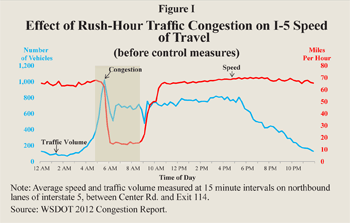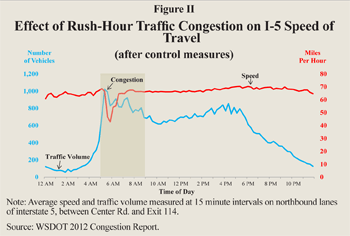Traffic congestion is a growing problem in many metropolitan areas. Congestion increases travel time, air pollution, carbon dioxide (CO2) emissions and fuel use because cars cannot run efficiently. The number of hours Americans waste sitting in traffic more than quintupled between 1982 and 2005, according to the Texas Transportation Institute.
Some people point to the growth of traffic congestion as evidence of the need for more infrastructure spending. However, there are ways to manage traffic, particularly at times of peak demand, that are relatively inexpensive.
How Traffic Congestion Occurs: Case Study of Interstate 5. Congestion begins when more vehicles try to use a road than the road can move. This can occur when vehicles cannot exit quickly enough to make way for others. For example, Figure I shows traffic flows throughout the day on the northbound lanes of Interstate 5, the busiest highway in Washington State, averaged over a two-day period following Labor Day 2010:
- The northbound average traffic capacity of I-5 is 59,000 vehicles per day, but as many as 66,000 vehicles use the highway daily.
- The start of school and continued growth in the number of vehicles exiting to Joint Base Lewis-McChord led to congestion from roughly 6 a.m. to 9:30 a.m.
- As a result, the speed of traffic plummeted from over 60 miles per hour to 15 m.p.h., tripling commute times and creating an 11-mile back-up of northbound traffic.
As the figure shows, once the road became congested, it took roughly three and one-half hours for traffic to return to normal speed.
 Within a month, however, the congestion problem was greatly alleviated by opening two more gates into the Joint Base and making other improvements, including better signage and signals. Figure II shows that by October 5, the congestion relief measures improved northbound morning speeds from 15 m.p.h. to 60 m.p.h. and reduced the duration of congestion to 15 minutes.
Within a month, however, the congestion problem was greatly alleviated by opening two more gates into the Joint Base and making other improvements, including better signage and signals. Figure II shows that by October 5, the congestion relief measures improved northbound morning speeds from 15 m.p.h. to 60 m.p.h. and reduced the duration of congestion to 15 minutes.
How to Solve Congestion Problems. The expensive way to deal with traffic congestion is to build so many new highway lanes that traffic never rises above peak use. This is especially expensive because if peak use lasts only a few minutes a day the new lanes will effectively be unused the rest of the day. Less expensive measures, such as those taken on I-5, discussed above, can also help.
 However, the low-cost solution to congestion is to encourage a few of the people who want to drive during those peak minutes to travel during a different part of the day. The most effective way to do this is to charge a toll during the peak minutes or hours, or to charge a toll all day and make the toll higher during peak periods. This is called congestion pricing. Hotels, airlines and phone companies all routinely use congestion pricing to prevent their systems from becoming overloaded. Applying congestion pricing to roads is doubly effective because it can keep flows from declining to below the maximum capacity of the road.
However, the low-cost solution to congestion is to encourage a few of the people who want to drive during those peak minutes to travel during a different part of the day. The most effective way to do this is to charge a toll during the peak minutes or hours, or to charge a toll all day and make the toll higher during peak periods. This is called congestion pricing. Hotels, airlines and phone companies all routinely use congestion pricing to prevent their systems from becoming overloaded. Applying congestion pricing to roads is doubly effective because it can keep flows from declining to below the maximum capacity of the road.
How Tolls Can Help Manage Demand. Many people object to paying tolls to use roads that have traditionally been “free,” which means paid for out of gas taxes. Yet the benefits of tolling congested roads are so great that many cities are beginning to experiment with such tolls. There are several different ways of doing this:
- New York City has converted fixed tolls to congestion tolls for existing toll roads and bridges to Manhattan. California has done the same with the San Francisco-Oakland Bay Bridge.
- Denver, Toronto and other cities charge tolls for newly constructed highways. This avoids charges that people are “paying twice” for roads, once out of gas taxes and once out of tolls, but does not relieve congestion on existing highways.
- California has built new toll lanes next to existing lanes, and Colorado and Minnesota have converted underused carpool lanes to tolled lanes, allowing people in low-occupancy vehicles to use the lanes if they pay tolls. By attracting cars away from existing lanes, everyone enjoys some congestion relief and anyone can drive in an uncongested lane if they are willing to pay a toll.
- London, Milan and a few other European cities have drawn a line (“cordon”) around their city centers and charge variable tolls to any vehicle crossing the line. However, because cordon charges do not distinguish between roads that are truly congested and those that are not, they are not as effective as individual road tolls.
- Oregon and Minnesota are experimenting with replacing gas taxes entirely with vehicle-mile fees that charge a fixed price per mile to drive on uncongested roads and variable prices to drive on congested roads. While many people worry that these systems will allow the government to track everyone’s travel, Oregon and Minnesota have designed their systems to protect people’s privacy.
Conclusion. With increasingly fuel-efficient cars, gas taxes are an ineffective way to pay for roads. Gas taxes are also collected mainly by federal and state governments, requiring local governments to find nearly $30 billion per year in general funds to subsidize roads. Mileage-based fees would eliminate congestion and solve these problems, as well as allow private parties to build or take over some roads. In any case, the growing use of tolls means the federal government has a declining role in highway funding.
Randal O’Toole is a senior fellow with the Cato Institute.